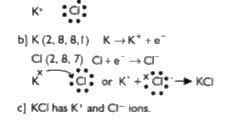a. Write the electronic dot structure of K and Cl.
b Show the formation of KCl by transfer of electrons.
c. Name the ion present in KCl.Solution in Kannada
a. Electron dot structure of potassium

Topper's Solved these Questions
- METALS AND NON METALSBOOK - ZEN PUBLICATIONCHAPTER - METALS AND NON METALSEXERCISE - ZEN ADDITIONAL QUESTIONS SECTION (LONG ANSWER [LA] TYPE 2 QUESTIONS)
14 Videos
- METALS AND NON METALSBOOK - ZEN PUBLICATIONCHAPTER - METALS AND NON METALSEXERCISE - ZEN ADDITIONAL QUESTIONS SECTION (SHORT ANSWER [SA] TYPE 1 QUESTIONS)
28 Videos
- CHEMICAL REACTIONS AND EQUATIONSBOOK - ZEN PUBLICATIONCHAPTER - CHEMICAL REACTIONS AND EQUATIONSEXERCISE - ZEN ADDITIONAL QUESTIONS SECTION (LONG - ANSWER [LA]TYPE QUESTIONS )
27 Videos
- PERIODIC CLASSIFICATION OF ELEMENTSBOOK - ZEN PUBLICATIONCHAPTER - PERIODIC CLASSIFICATION OF ELEMENTSEXERCISE - QUESTIONS
2 Videos
Similar Questions
State one property of each of the following which makes them suitable for the followng:
a. Copper and aluminium for making electric wires
b. Gold, platinium and silver are used to make jewellery
c. Copper to make hiot water tank
d. Graphite in making electrodes
e. Alloys for making bells and strings in musical instruments.
View SolutionYou are given three metals: sodium, magnesium, and copper. Suggest any two activities to arrange them in order of their reactivity.
View SolutionBalance the following chemical equation
P4+O2→P2O5
View SolutionThe electronic configuration , group number and period number of an element with atomic number 10 is
View SolutionThe conductivity of molten KCl is due to the movement of K⊕ and Clc− ions.
View Solution(i) Write the electron-dot structures for sodium, oxygen and magnesium.
(ii) Show the formation of Na2O and MgO by the transfer of electrons.
(iii) What are the ions present in these compounds?
View Solution(i) Write electrondot structures for magnesium and oxygen. ltBrgt (ii) show the formation of MgO by the transfer of electrons. ltBrgt (iii) . What are the ions present in this compound?
View Solution(a) Write the electron dot structure for calcium and oxygen. The atomic numbers of calcium and oxygen are 20 and 8 respectively. (b) Show the formation of calcium oxide by the transfer of electrons. (c) Ionic compounds are high melting solids. Give reason.
View Solution(i) Write the electron dot structure for sodium, oxygen and magnesium.
(ii) Show the formation of Na2O and MgO by the transfer of electrons.
(iii) What are the ions present in these compounds.
View Solutiona. Write electron dot diagram for chlorine (At No. 17) and Calcium (At No 20) show the formation of Calcium chloride by transfer of electrons.
View Solution(i) Write the electron-dot structures for sodium, oxygen and magnesium.
(ii) Show the formation of Na2OandMgO by the transfer of electrons.
View SolutionCalculate the ionic radii of K+andCl− ions in KCl crystal. The internuclear distance between K+ an Cl− ions are found to be 3.14Å.
View Solution(i) Write the electron-dot structures for sodium, oxygen and magnesium.
(ii) Show the formation of Na2O and MgO by the transfer of electrons.
(iii) What are the ions present in these compounds?
View Solution(i) Write the electron-dot structures for sodium, oxygen and magnesium. (ii) Show the formation ofNa2O and MgO by the transfer of electrons. (iii) What are the ions present in these compounds ?
View Solution(i) Write the electron-dot structures for sodium (11) oxygen (8), chlorine (17) and magnesium (12) show the formation of Na_(2)O and MgO by the transfer of electrons. (ii) Name the ions present in these compounds.
View Solution(i) Write the electron dot structure for sodium, oxygen and magnesium. (ii) Show the formation of Na_(2)O and MgO by the transfer of electrons. (iii) What are the ions present in these compounds.
View Solution
